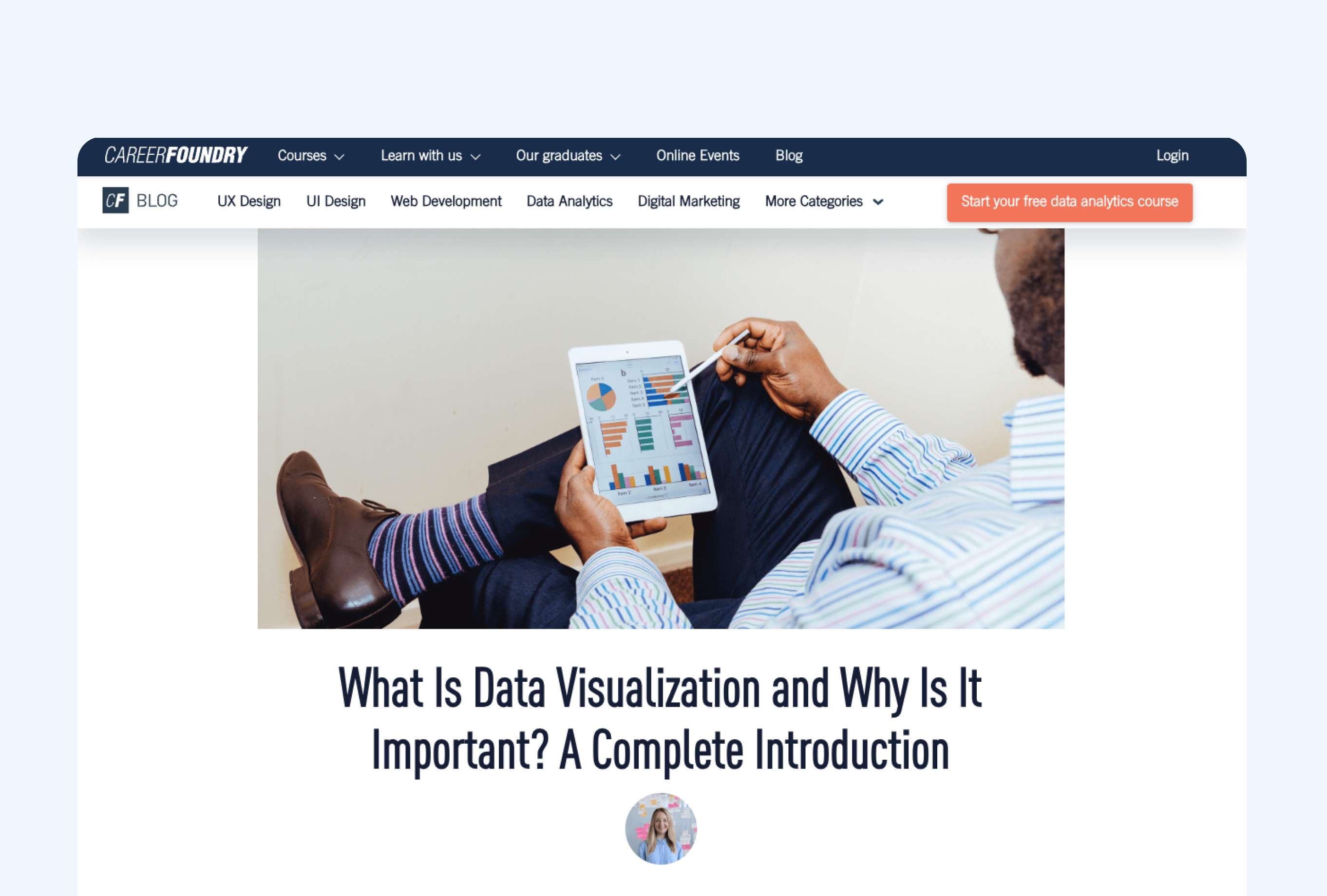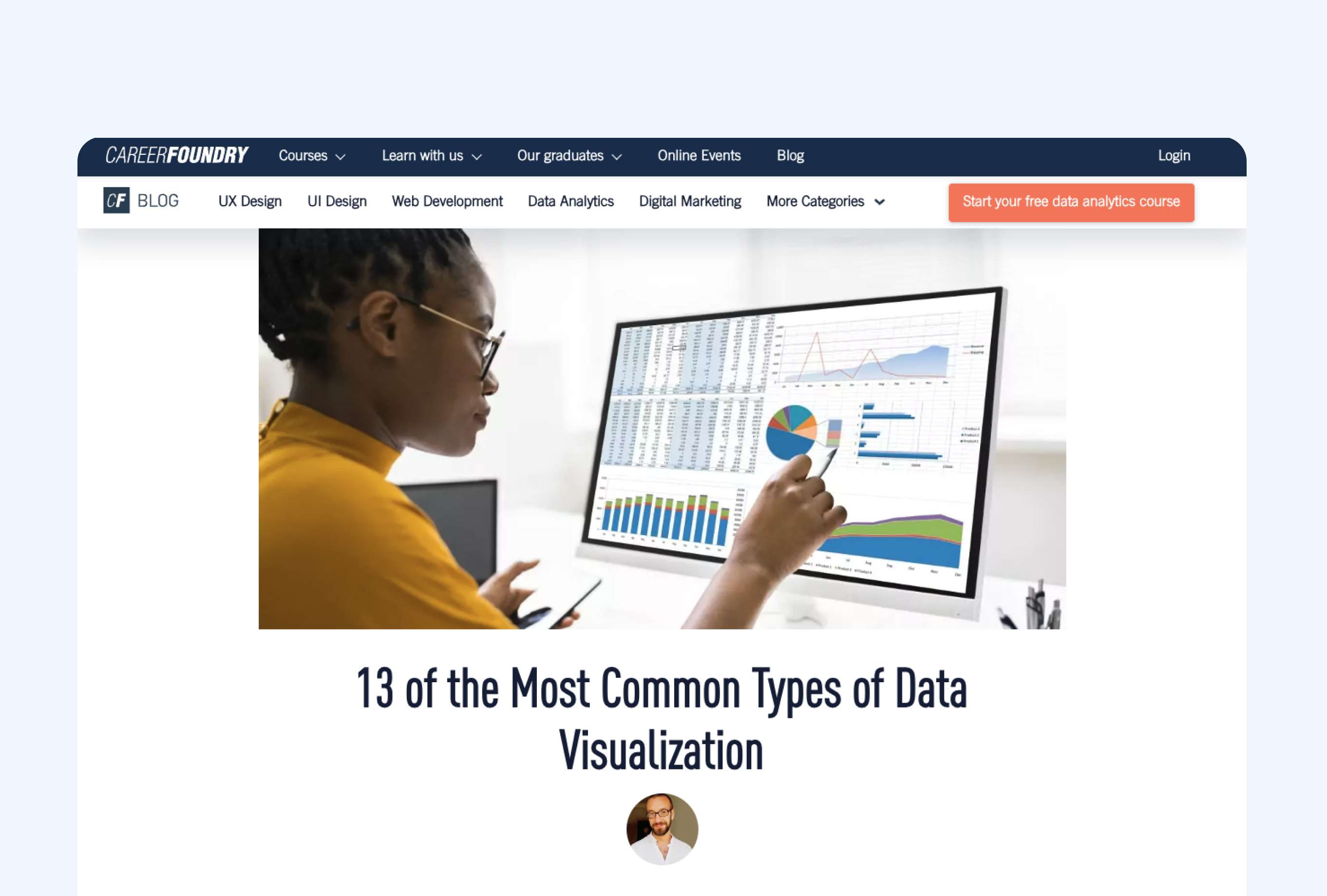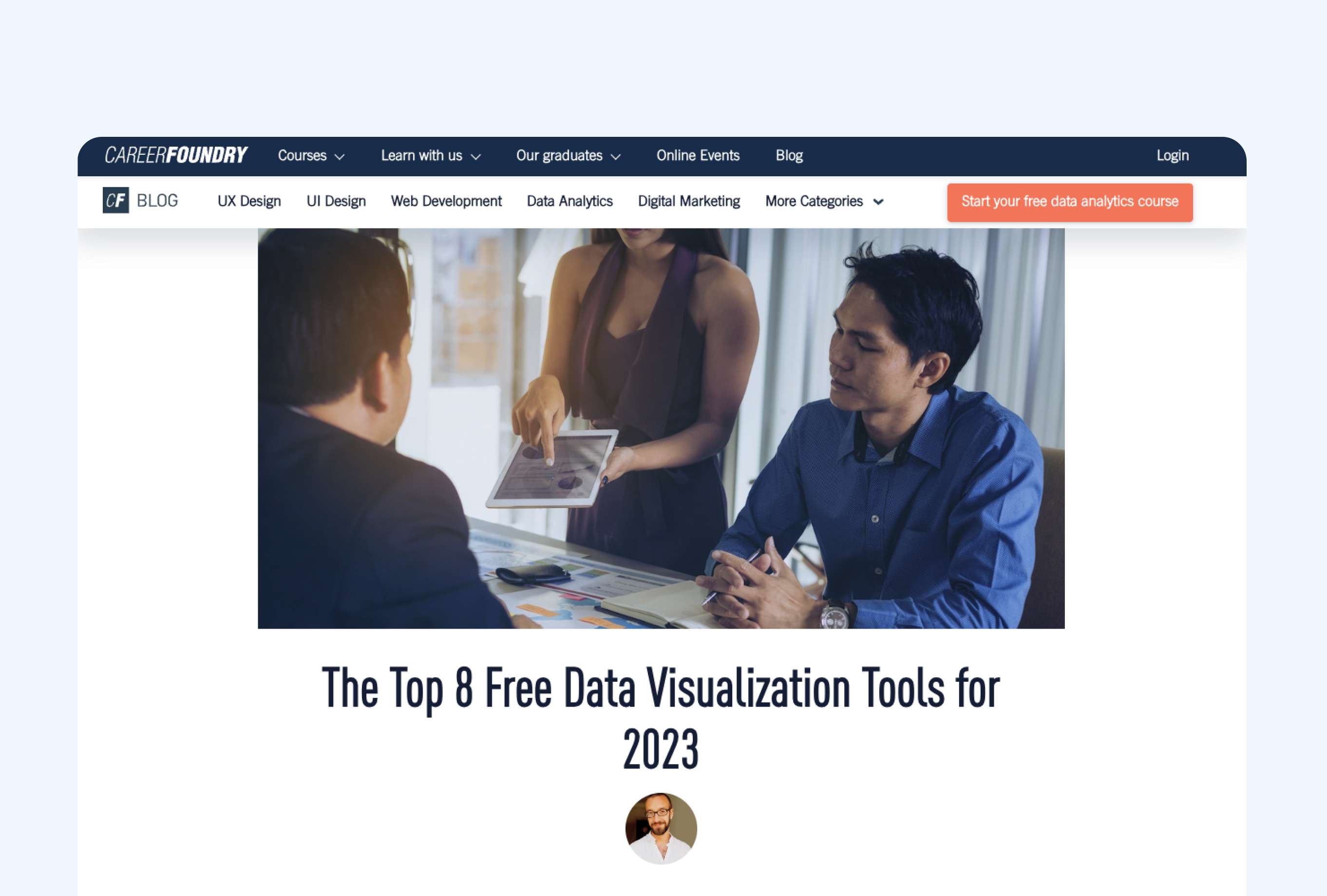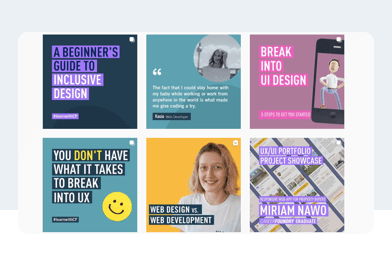Data Visualizations with Python
Want to know more about the course?
Thanks!
Curious about this course?
Contact us to find out if it’s right for you

“How would you like to get in touch?”
“I’m here to help you become a Data Visualizations expert!”
Alana, Senior Program Advisor
Curious about this course?
Contact us to find out if it’s right for you

“How would you like to get in touch?”
“I’m here to help you become a Data Visualizations expert!”
Alana, Senior Program Advisor
Data Visualizations with Python Course details
In this course, you will
Learn the fundamental principles of data visualization, and apply them to a real-world project.
Use Python to conduct advanced analyses using data visualization algorithms.
Gain proficiency using different visualization libraries in Python.
Work 1:1 with an expert mentor, who'll provide you with individualized support, advice, and feedback.
Join an active community of over 5000 graduates and 700 instructors, and get access to exclusive events and webinars.

Fully online
Study for an average of 15–20 hours per week for 2 months
Personalized mentorship
Our course mentors are rated 4.96/5
Outcome-oriented
Finish with a certificate of completion and complete portfolio project
Why learn data visualizations?
Deepen your understanding of Python
By learning Python-based visualizations, you’ll not only improve your Python library proficiency, you’ll also pave the way for transitioning into data sciences.
Boost your career with data visualization skills
Supercharge your resume—whether you want to work on a side project, build your own business, or simply contribute a broader skillset to your company, learning data visualization is a surefire way to maximize the value you provide.
Data visualization experts are in high demand
Employers highly value analysts who possess the ability to present data in a user-friendly and comprehensible manner, enabling effective communication across various sectors within an organization.
Why choose a CareerFoundry course?
Work with your very own course mentor
You'll enjoy a truly collaborative online learning experience, with tailored written and video feedback on everything you do from an expert who works in your new field day in, day out.
Get the perfect balance of theory and practice
With a curriculum designed in-house in collaboration with leading data visualization experts, the course will help you get to grips with various Python libraries, and presenting your insights using an interactive dashboard.
Finish with a job-ready portfolio
Guided by the expert advice of your mentor, you’ll finish the course with a portfolio, complete with a professional case study that showcases your ability to think like a data visualization expert.
Data visualization transforms data into powerful visualizations and provides tactical, operational, and strategic insights.
Meet your new team
At CareerFoundry, you’re never alone! From the moment you start the course, you’ll be assigned a personal mentor. This seasoned and influential expert will act as your teacher, coach, and confidant through every step of the course—providing individualized support, advice, and feedback.

Your mentor
Your mentor will provide detailed video reviews of each project you complete during the course.
Our mentors haven’t just made a name for themselves at top companies in the industry—but have helped shape it.
A project-based curriculum that gets you thinking like a data visualization expert.
Learn the skills you need to stand out as a data analyst with data visualization skills.
Created by experienced instructional designers, authored by industry experts, and kept up-to-date by course editors, our curriculum will serve as the foundation of your learning experience.
Achievement 1: Network Visualizations and Natural Language Processing with Python
1.1 Intro to Freelance and Python Tools
Analyze tools for writing and executing Python code and evaluate the advantages and disadvantages of different tools by summarizing their efficacy in various data analytics projects.
1.2 Setting up the Python Workspace
Apply knowledge of GitHub commands by cloning a repository and performing push and pull requests, create an SSH key to access a repository from a local machine, and execute code to push new requests in a GitHub repository.
1.3 Virtual Environments in Python
Demonstrate an understanding of anaconda by creating and activating a virtual environment and execute apply() and lambda() functions to create a flag column in Anaconda.
1.4 Accessing Web Data with Data Scraping
Explain the legal and ethical intricacies of data scraping by checking the terms of use.
Organize an environment to perform a data scrape by implementing Python libraries into a virtual environment and execute a data scrape on a website to collect web data.
1.5 Text Mining
Apply text mining techniques to a data set, evaluate various text mining techniques to perform a particular analysis, and create bar plots to showcase text mining data.
1.6 Intro to NLP and Network Analysis
Evaluate data format by determining if a data set needs wrangling, apply a Natural Language Processing algorithm to text, and apply output from an NLP algorithm to create a data frame for network analysis.
1.7 Creating Network Visualizations
Create a network graph using Python code, analyze the quality of a network graph by explaining how it can be improved, and apply improvements to a network graph to create a final iteration.
Achievement 2: Dashboards with Python
2.1 Tools for Creating Dashboards
Analyze different visualization tools by comparing their usability in different scenarios, analyze the different Python libraries available for dashboards by conducting research, and evaluate a Python dashboard.
2.2 Project Planning and Sourcing Web Data with an API
Analyze a task by creating a list of questions to solve a problem, and develop a plan to create a dashboard.
Apply an API to a web page to gather data and apply Python code to structured and unstructured data sets to clean and merge them.
2.3 Fundamentals of Visualization Libraries 1
Differentiate between procedural and object-oriented programming, create bar and line charts using Matplotlib.
Define components in visualization charts by applying customization features and analyze visualizations to interpret data.
2.4 Fundamentals of Visualization Libraries 2
Create bar and line charts using Seaborn, analyze a categorical variable using a visualization, and explain the benefits of utilizing a FacetGrid for analysis.
2.5 Advanced Geospatial Plotting
Apply functions in Python to aggregate data, create a geospatial plot using Kepler.gl, and analyze a map by applying filtering to recognize patterns in data.
2.6 Creating a Python Dashboard
Create charts in Plotly, execute a Python script to run a program, apply code to initialize a Python dashboard in Streamlit, and create a dashboard integrating multiple Python libraries.
2.7 Refining and Presenting a Dashboard
Apply fundamental design principles to a dashboard, create a multipage dashboard using Streamlit, deploy a dashboard using Streamlit, and analyze data by interpreting visualizations and deliver an analysis through a presentation.
Price
Data Visualizations with Python
- Learn through our comprehensive, project-based curriculum
- Receive regular, personalized feedback from your course tutor
- Deliver two data visualization projects, which will form the basis of your professional portfolio
- Get an in-depth review of your portfolio project from your mentor on a video call
- Gain exclusive access to our global community—plus events and webinars
FAQ
This course is for those who would like to learn how to use Python to conduct advanced analyses using data visualization algorithms and models. The Data Visualizations with Python Course is available as a specialization course for our Data Analytics Program, or it can be taken as a standalone course.
To successfully complete the course, you’ll need to have experience with the programming language Python. You’ll also need to have experience with tools and software such as Excel and Jupyter Notebook, and experience working with statistical algorithms. You should be comfortable using many of the common libraries for working with data, for instance, Pandas, NumPy, and Seaborn. It’s also necessary to have practiced executing basic Python commands in Jupyter Notebook or a similar tool, such as Google Colab, nteract, VS Code, or JupyterLite.
Additionally, you’ll need:*
- Interest in machine learning
- Written and spoken English proficiency at a B2 level or higher
- A computer (macOS, Windows, or Linux) with a webcam, microphone, and an internet connection.
*Note: You will be required to invest some independent study time (approximately 1-2 hours per week) towards familiarizing yourself with the tools you’ll use throughout the course, and learning how to use them.
You’ll be using the tools; Jupyter Lab, GitHub, Anaconda, and Python. You'll also use a Word Processing tool and a Presentation tool of your choice.
All the tools and software you’ll need are free to use—with no additional cost to you.
Compatible operating systems: Windows 11, macOS versions 10.13 and later, Ubuntu, Debian, CentOS, or Fedora (Linux).
Questions? Contact us for more information on requirements for your specific operating system.
Yes, the course is entirely asynchronous and online—so you can study when and wherever you’d like so long as you can get online and complete the course on time.
But this doesn’t mean the learning experience is isolated or lonely! You’ll have your mentor, tutor, and student advisor there to support you—as well as access to our active student community on Slack.
We take a rigorously practical approach to learning. You’ll have the opportunity to apply everything you learn in practical ways. Every exercise builds up to a completed portfolio project that your mentor will review and that will show employers the in-demand skills you learn in the course.
If you set aside 15-20 hours per week to study, you’ll complete the course in approximately two months (eight weeks). If you’re able to devote 30-40 hours per week, you can complete the course in about a month (four weeks).
This course offers immersive training in the field of data visualization—including expert-authored curriculum, hands-on projects, and personalized mentorship and support from experts in the field. Everything you need to stand out in the field as the specialist you’ll be.
Find out more here:
- How it works: From the curriculum to your support team, and beyond—here are the details.
- Meet our mentors: Get to know who the CareerFoundry mentors are and how the dual-mentorship model works.
- Graduate outcomes: Here’s some of the work our graduates did in the full program—and where they’re at today.
Yes, we offer two payment options for your specialization course. First, you can save a little money by paying your full tuition up front. If that’s not feasible, you can pay a set amount up front (varies depending on currency), and then the remainder in three monthly payments.
While the course is not university accredited, it does undergo a rigorous quality assurance and certification process with the ZFU (Staatliche Zentralstelle für Fernunterricht)—the state body for distance learning in Germany.
This process ensures that the course meets a high stand for an excellent and effective learning experience.
On successful completion of this certification process, the course is assigned a unique approval number (7443623) which can be checked against a public register. 
How would you like us to contact you?
Book a time to speak with a program advisor
Send us a message


What questions do you have about the program? We're happy to help.
Thank you!
Our program advisor will be in touch with you shortly.







